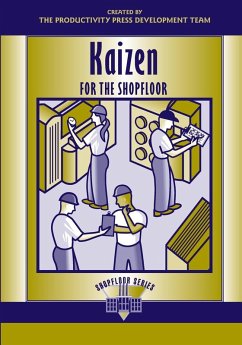
New Shop Floor Management
Empowering People for Continuous Improvement

PAYBACK Punkte
13 °P sammeln!
In this first comprehensive departure from the time-and-motion dictums of Frederick Taylor's Shop Management that have influenced management practices for most of this century, Kiyoshi Suzaki offers a framework for successfully conducting business at its most crucial point-the shop floor. Drawing on the principles of holistic management, where organizational boundaries are smashed and co-destiny is created, Suzaki demonstrates how modern shop floor management techniques -- focusing maximum energy on the front line -- can lead to dramatic improvements in productivity and valueadded-to-services....
In this first comprehensive departure from the time-and-motion dictums of Frederick Taylor's Shop Management that have influenced management practices for most of this century, Kiyoshi Suzaki offers a framework for successfully conducting business at its most crucial point-the shop floor. Drawing on the principles of holistic management, where organizational boundaries are smashed and co-destiny is created, Suzaki demonstrates how modern shop floor management techniques -- focusing maximum energy on the front line -- can lead to dramatic improvements in productivity and valueadded-to-services. The role of management today, Suzaki argues, is to eliminate its own responsibilities by thinking of the organization from the genba, or shop floor, point of view. In this challenge, Suzaki claims, organizations need to collect the wisdom of people by practicing "Glass Wall Management," where organizations become transparent, enabling employees to contribute maximum creativity as opposed to blocking their potential with what he calls "Brick Wall Management." Further, to empower individuals to selfmanage their work and satisfy their customers, Suzaki asserts that they all should learn to manage their own "mini-company," where everybody is considered president of his or her area of responsibility. Front-line supervisors, Suzaki shows, must develop a mission and goals and share them both up and downstream. He cites examples of the "shop floor point of view" -- McDonald's Corporation's legal staff learning how to sell hamburgers and fix milkshake machines; Honda's human resource staff training on the assembly line -- that narrow the gap between top management and the shop floor. By upgrading people's skills, focusing on empowerment, and streamlining processes, Suzaki illustrates that an organization will realize concrete improvements in quality, cost, delivery, safety, morale, and ultimately, its competitive position.














